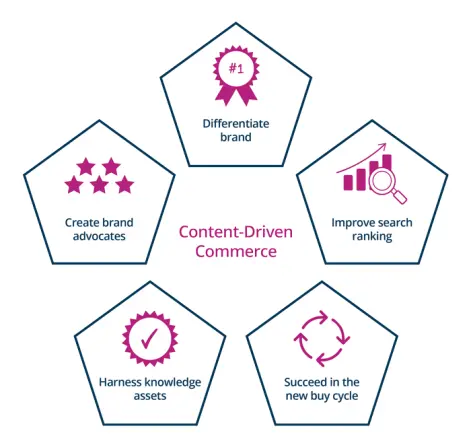Five Reasons Leading B2B Brands are Embracing Content-Driven Commerce
There’s a revolution occurring in B2B commerce: While B2B has traditionally lagged behind B2C in adoption of e-commerce technologies, B2B buyers are increasingly following the same pattern they’ve grown used to in B2C shopping scenarios, and the market is responding. With 2/3 of B2B buyers now opting for digital self-service , the days of in-person visits from sales people and paper based-RFPs are waning, and enterprises are racing to adapt to the fast-changing buy cycle and capture the new market opportunities. To put this in perspective, in 2020, the global B2B e-commerce market size was valued at USD 6.64 trillion and is expected to expand at a compound annual growth rate (CAGR) of 18.7% from 2021 to 2028. This presents an enormous opportunity for B2B enterprises to grow their sales pipeline.
To reach and nurture their customers in the new buy cycle, B2B sellers must engage them with content throughout their digital buyer’s journey. This isn’t just a future-looking idea, it’s the reality of business today – and if you aren’t delivering, your competitors will.
In our last post, we talked about the best strategic and technological models for delivering next-generation B2B commerce experience and why a headless content-driven approach is the future . Here we share insights learned from our customers who have adopted this model, the critical business imperatives driving their approach, and how it’s shaping the way they engage with their customers.

But first, what is content-driven commerce?
Before we dive into this topic, let’s recap what we mean by content-driven commerce. Content-driven commerce is about creating next-generation digital shopping experiences that go beyond transactions by engaging customers with personalized, multi-channel content at every stage of the buy cycle.
Traditionally, e-commerce platforms are built around transactions and content is limited to core product and company information including:
- Homepage
- Product pages
- Technical pages about the products
- Search bars
- Shopping carts and checkout
- Partner or customer pages
While not a bad place to start, this structure is very product-centric – here’s what the product is and here’s what it does.
In contrast, a content-driven approach is about making your brand and your products come to life – engaging customers with storytelling, embedding product information in consumable media (think interactive images, shoppable videos), and providing prospects with all the information and tools they need to make, often complex, buying decisions online.
Five drivers for a content-driven commerce strategy
Moving from a product-driven to a content-driven approach requires disruption and a significant shift in organizational mindset, but the payoffs for progressive sales organizations can be huge. We spoke to our customers about what’s driving their approach and the value they’re realizing in terms of increased revenue, improved customer experience and customer loyalty.
Here are five critical business drivers:

- 1. Differentiate brand— In today’s hyper-competitive digital marketplace content is king. Any company throwing their hat into the ring alongside the dominant players will need to deliver something extra. When it comes to making online purchases, most people make their decisions based on two factors: the convenience and quality of the user experience. It’s hard to beat the sheer convenience of the big players, but the quality of the CX is an area where you can win. With a content-driven approach, organizations can seize competitive advantage over their transaction-focused competitors through superior, personalized, content-driven sales experiences. In the world of B2B where buying decisions are complex and high-stakes, the ability to deliver compelling and supportive digital sales experiences is what sets businesses apart.
- 2. Improve search ranking—With visibility in the search engines critical to driving new leads, SEO has become a priority for business development, and is one of the fastest growing spends in the B2B sector . Taking a keyword-rich content-driven approach provides a significant advantage for boosting organic search versus pure-play transactional websites. In addition, around a third of all the searches in the e-commerce sector are for information about products that customers need to support their buying decision. For companies adopting a content-driven strategy, their buyers’ guides, how-tos, infographics, videos, tutorials and user-generated content, are effectively an SEO treasure trove with the potential to boost rankings and drive valuable “high-intent” / low bounce searches, which in turn lead to higher conversions.
- 3. Succeed in the new buy cycle—As mentioned above, the B2B buy cycle is changing fast and digital self-service is now the most popular way for B2B buyers to make their purchases . Accelerated by the pandemic and the rise of digitally native Millennials and Gen Zs, online has become the dominant channel for all stages of the B2B buying process, including: identifying and researching new suppliers (37%), considering and evaluating new suppliers (34%), ordering (37%) and reordering (38%). Taking a personalized, multi-channel, content-driven approach is essential if organizations are to address the needs of their customers in the channels and formats they want it.
- 4. Harness knowledge assets—Everybody is looking for reliable content, but with so much noise being produced online, it’s hard for customers to know who to trust when it comes to information about products and solutions. B2B organizations have built their businesses on a wealth of knowledge and expertise and are true experts in their areas. With a content-driven approach, this highly marketable resource can be leveraged to create valuable information-rich assets for prospects and customers, building brand equity and nurturing long-term customer relationships.
- 5. Create brand advocates—Building products to tackle specific customer needs is paramount to your company’s success, but don’t overlook the importance of inspiring them. As Steve Jobs once said, "Life is about creating and living experiences that are worth sharing." Savvy B2B enterprises are connecting with their customers to find out how they’re using their products, the impact that those products are having, and how they feel when using these products. Leveraging inspirational stories as part of a content-driven strategy is a powerful means of amplifying customer success and turning users into loyal fans who advocate for your brand.
If you want to build engagement with new customers, keep current customers coming back for more, and leave your competitors in the dust, consider implementing a content-driven commerce approach.
To learn more, speak to an expert today →
